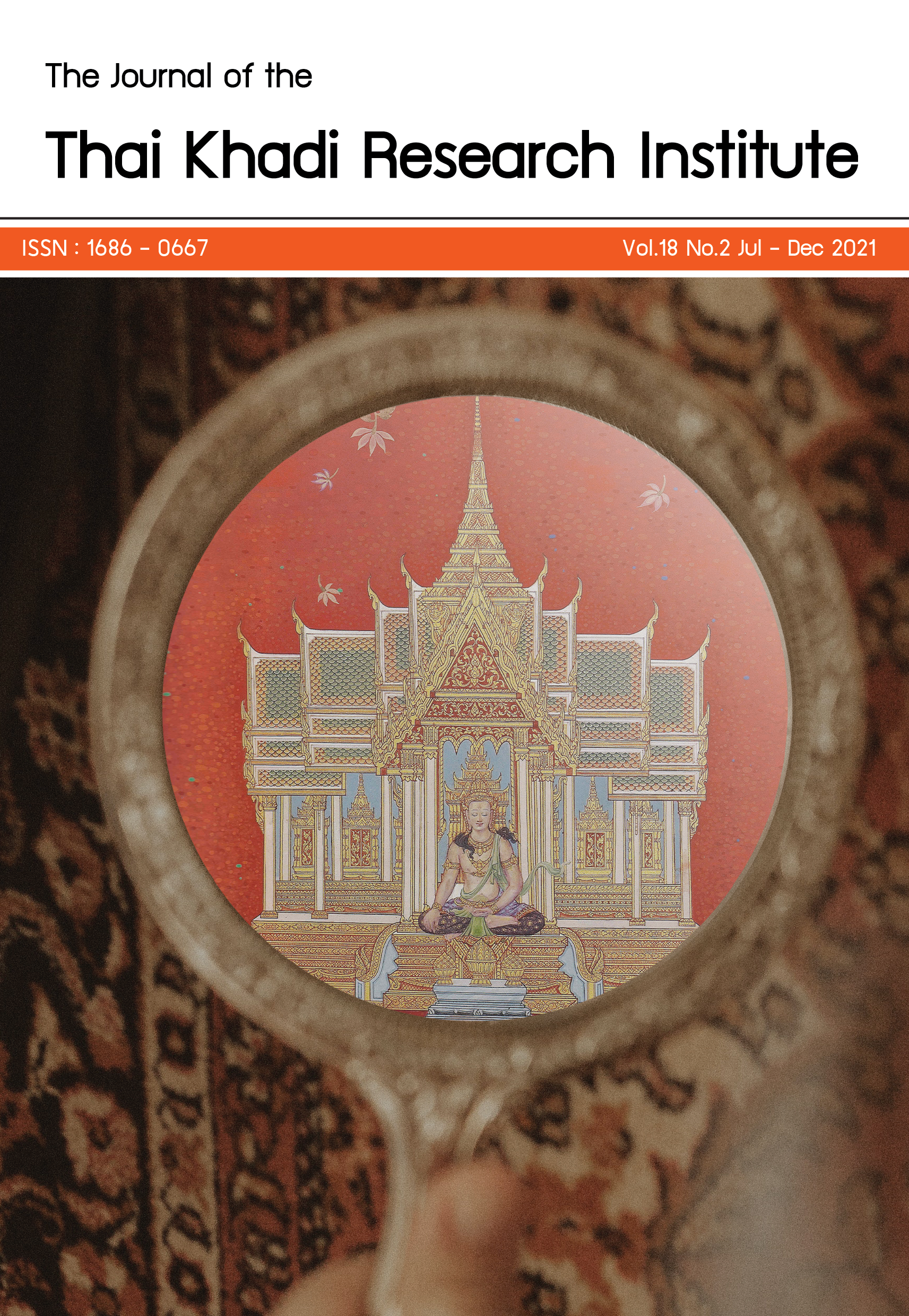‘Religion’ is the state of knowledge and faith of mankind, reflecting the beginning, existence and end of ‘social phenomenon’ and ‘events’ in Thai and global societies. In particular, in the contexts of the COVID-19 pandemic, religion has become a mirror of samsara or the wheel of birth, old age, sickness and death while serving as a spiritual anchor to those who seek a way to get out of the crisis. In this situation, the Journal of the Thai Khadi Research Institute Vol.18 No.2 presents research articles derived from the interpretation and comparative study of different issues on dynamic impacts of social phenomenon and events.
The Connotations of Meritorious Action in Buddhism and Social Phenomenon by Tiamjit Puangsomjit. This article analyzes the meaning of punna or meritorious actions, a type of action in Buddhism classified as wholesome actions. Findings reveal that at the lexicon or worldly level, punna means happiness, the purification of innate characters, merit, and meritorious behaviors; at the connotation or dhamma level, it means renouncement, wisdom, supreme happiness, and nirvana. This implies that happiness is the sole meaning of punna at both Lokiya and Lokuthala levels and that the level of punna depends on the intention of the person who commits punna. At present, people make merits by giving with a desire for happiness, success and wealth rather than giving as an act of renouncement.
The Date of King Jayavarman VII’s Accession to the Throne: Its Relationship with the Interpretation of Bhutasamkhya, Veda Beliefs, and Political Contexts by Nipat Yaemdet, Chirapat Prapandvidya and Sombat Mangmeesukhsiri. The article discusses the date of King Jayavarman VII’s accession to the throne as recorded in Arogyasala and Pimeanakas inscriptions by four words: Veda-the sky-the number one-the moon. The date is still a subject for scholarly debate due to the interpretation of the word ‘Veda’. Considering the Bhutasamkhya system and beliefs of ancient India that the Brahmin see the four Vedas and thus have four eyes, the authors are of the opinion that the word ‘Veda’ denotes the number ‘4’, not the number ‘3’ (Veda=4, the sky=0, the number one=1, the moon=1); hence the date of King Jayavarman VII’s accession to the throne is the Saka era 1104 (A.D.1182, B.E. 1725).
Cultural Development of Ancient Communities in the Area between Loei and Nam Mong River Valleys before the 14th Century, Based on Archaeological Evidence by Kulavadi Samackthai, Dararat Mattariganond and Wiangkum Choun-u-dorn. This article presents a study on the cultural development of ancient communities in northeastern Thailand during prehistoric and historic periods. Findings reveal the establishment of the incipient community on the Mekong River at the north of Sakon Nakon basin, dating from 5,500 - 2,700 BE. Dating from the eight century AD, there existed ancient communities of Dvaravati culture. Theravada Buddhism was influential in this area during the early historic period, except for those communities where Mahayana Buddhism and Khmer art from Cambodia were combined.
From OTOP to OTOP Nawatwithi: A Community-Based Development Policy? by Kanjana Laochockchaikul. This article analyzes the implementation of OTOP Nawatwithi Tourism Community Policy, a national development policy organized by Community Development Department, Ministry of Interior, focusing on its community and local wisdom-based concepts. It was found that there are some changes in community-based concepts incorporated in OTOP and OTOP Nawatwithi policies. The concepts have never been realized, however due to the centralized and top-down characters of all development organizations involved.
Pat Salat: A Musical Onomatopoeia in Mon Palm Leaf Scripture by Jarun Kanchanapradit, Jatuporn Seemuang, Tharanat Hin-on, Vassakarok Kaewloy and Wanida Bhrammaputra. This article analyzes the musical onomatopoeia of Pat Salat, a major Mon musical instrument mentioned in a palm leaf scripture entitled Kayak Che Nu Fo (The Buddha Descending from Heaven) while illustrating the sound in the poet’s imagination that reflects the influence of music in Mon culture in the past as well as the relationship between music and Mon people’s faith in Buddhism.
A Comparative Study of Drug Remedies in the Pharmacopoeia of Wat Mai Phromphiram, Phitsanulok Province, and Those in the Official Traditional Thai Medicinal Scripture by Phakphon Sangngern. This article studies the remedies of five Thai herbal medicine recorded in 1867 in the pharmacopoeia of Wat Mai Phrompiram, Phitsanulok Province, in comparison with drug remedies of similar names and contents in the Official Traditional Thai Medicinal scripture, revised and compiled in 1870 under the order of King Chulalongkorn. It was found that the contents of one drug remedy, Tamrubya Brahma Bhaktra, in Wat Mai Phrompiram pharmacopoeia mostly resemble those in the official scripture, except for some minor differences in efficacy.
The Journal of the Thai Khadi Research Institute Vol.18 No.2 presents a book review of Buddha Images, Amulets, From the Crypt of Wat Ratchaburana’s Prang, Ayutthaya Province by Prof. Sakchai Saising, Ph.D., Department of Art History, Silpakorn University. Highlight include new findings and the division of arts in Khmer culture from those of central Thailand. Brief reports on academic, arts and cultural activities organized by the Thai Khadi Research Institute from July through December, 2021, are also included.
It is hoped that the Journal of the Thai Khadi Research Institute will be a forum and mediation for dissemination and exchange of knowledge on “Thai studies” that benefits the academic community and the general public as well. Any contributions to the Journal, either by article submission or readership are highly appreciated.
Published: 2021-12-21


